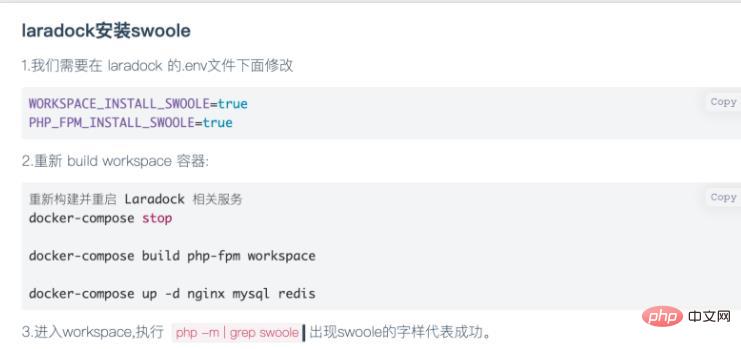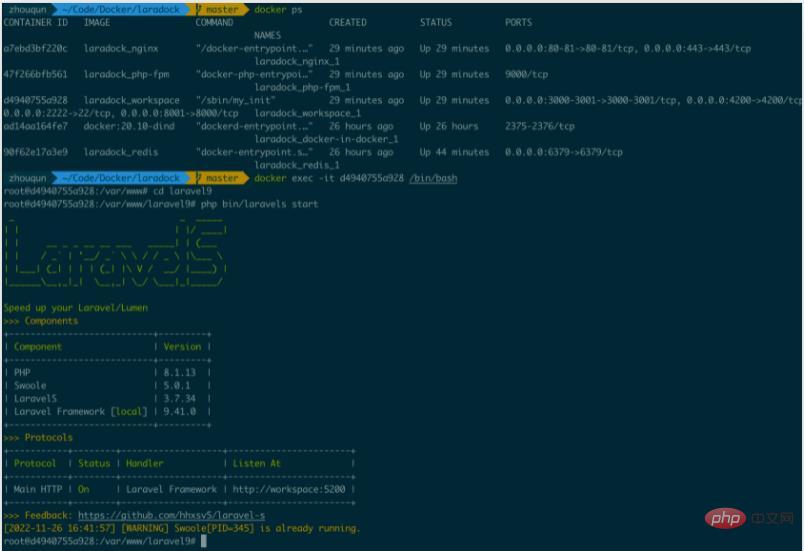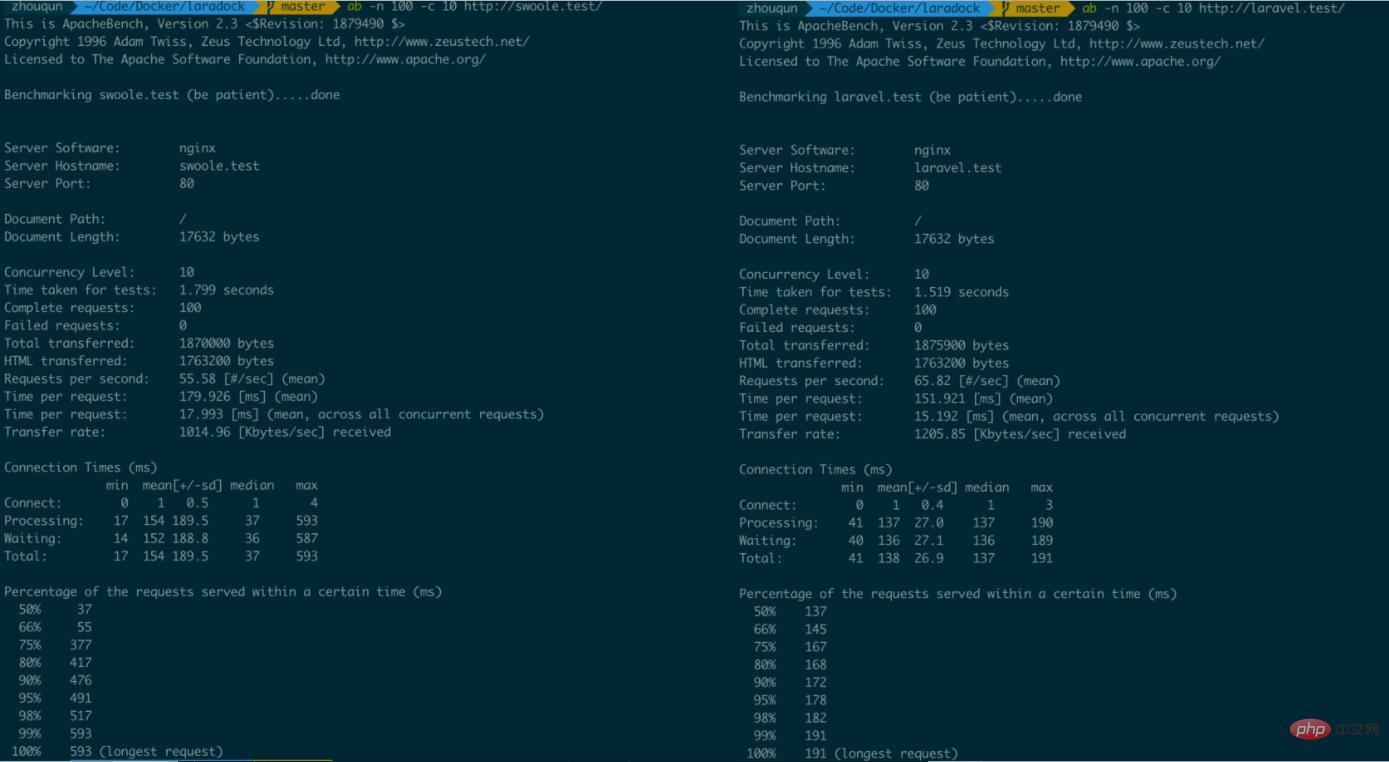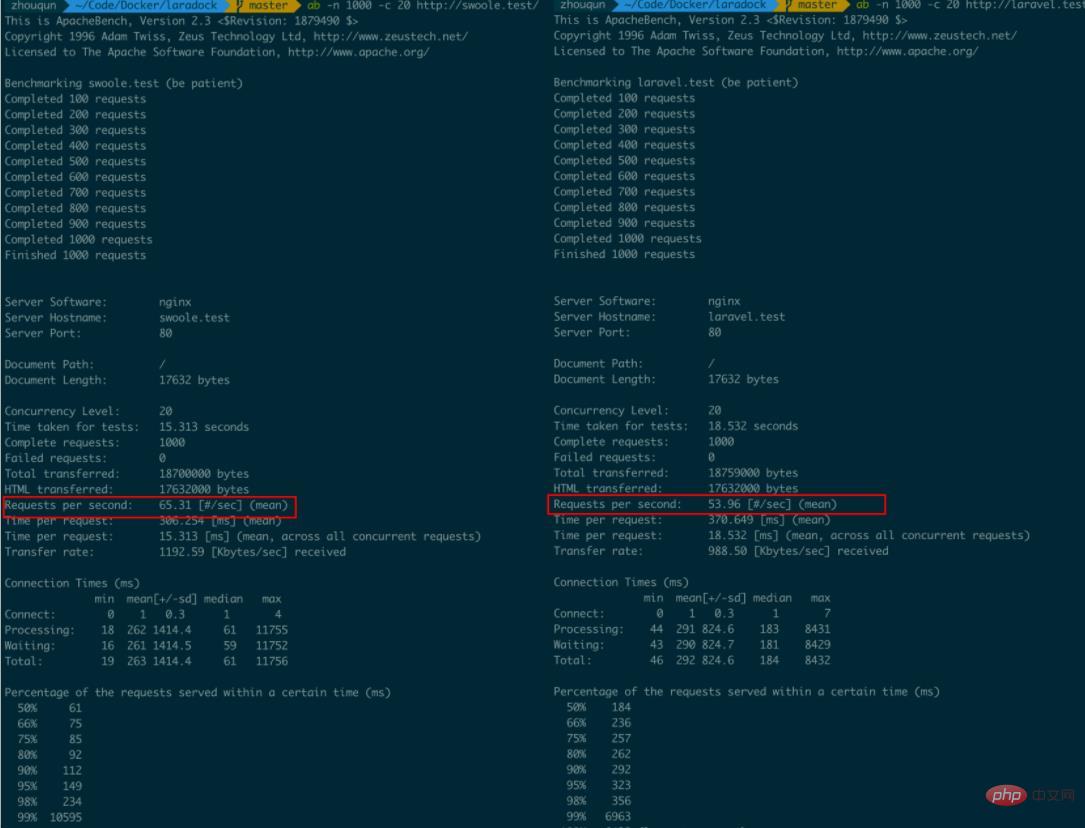前言:最近想使用 swoole 试试 websocket, 正好安装测试下 laravel 和 swoole 性能,不知道是不是 laravel9 性能优化的好,最后压测结果和 laravels 的差不多~
laradock 安装 swoole

动手操作后遇到问题:
因为原先的 PHP 版本是 7.4,需要修改.env 文件,将版本切换到 8.0 及以上 (laravels 安装的时候要求 php 是 8.1,所以还是设置成 8.1 版本的):
再次执行 build 命令后成功。【推荐:laravel视频教程】
验证结果:
配置 laravels 的 http 服务器
教程很多,此处参考自:Laravel 9 中文文档 - 安装
基于 安装了 docker 的环境
curl -s "https://laravel.build/laravel9" | bashCopy
composer require hhxsv5/laravel-sCopy
php artisan laravels publishCopy
说明: 站点对应的项目代码都是 /var/www/laravel9/public
(1) 配置 laravels 的 http 服务器
upstream laravels {
# Connect IP:Port
server workspace:5200 weight=5 max_fails=3 fail_timeout=30s;
keepalive 16;
}
server {
listen 80;
server_name swoole.test;
root /var/www/laravel9/public;
index index.php index.html index.htm;
# Nginx 处理静态资源,LaravelS 处理动态资源
location / {
try_files $uri @laravels;
}
location @laravels {
proxy_http_version 1.1;
proxy_set_header Connection "";
proxy_set_header X-Real-IP $remote_addr;
proxy_set_header X-Real-PORT $remote_port;
proxy_set_header X-Forwarded-For $proxy_add_x_forwarded_for;
proxy_set_header Host $http_host;
proxy_set_header Scheme $scheme;
proxy_set_header Server-Protocol $server_protocol;
proxy_set_header Server-Name $server_name;
proxy_set_header Server-Addr $server_addr;
proxy_set_header Server-Port $server_port;
proxy_pass http://laravels;
}
error_log /var/log/nginx/swoole_test_error.log;
access_log /var/log/nginx/swoole_test_access.log;
}注意:laravels 项目需要在 laravel9 项目下的.env 文件中增加以下配置:
LARAVELS_LISTEN_IP=workspace LARAVELS_DAEMONIZE=trueCopy
(2) 配置普通 laravel 项目站点
server {
listen 80;
listen [::]:80;
# For https
# listen 443 ssl;
# listen [::]:443 ssl ipv6only=on;
# ssl_certificate /etc/nginx/ssl/default.crt;
# ssl_certificate_key /etc/nginx/ssl/default.key;
server_name laravel.test;
root /var/www/laravel9/public;
index index.php index.html index.htm;
location / {
try_files $uri $uri/ /index.php$is_args$args;
}
location ~ \.php$ {
try_files $uri /index.php =404;
fastcgi_pass php-upstream;
fastcgi_index index.php;
fastcgi_buffers 16 16k;
fastcgi_buffer_size 32k;
fastcgi_param SCRIPT_FILENAME $document_root$fastcgi_script_name;
#fixes timeouts
fastcgi_read_timeout 600;
include fastcgi_params;
}
location ~ /\.ht {
deny all;
}
location /.well-known/acme-challenge/ {
root /var/www/letsencrypt/;
log_not_found off;
}
error_log /var/log/nginx/laravel_error.log;
access_log /var/log/nginx/laravel_access.log;
}(3) 本地 host 配置
127.0.0.1 swoole.test127.0.0.1 laravel.testCopy
(4) 重新 build 容器
docker-compose stop docker-compose build workspace nginx docker-compose up -d redis mysql nginx workspaceCopy

(5) 进入 workspace 容器启动 laravels
进入容器命令:
docker exec -it d4940755a928 /bin/bashCopy

AB 性能测试结果
1.总请求数是 100,并发数是 10(左侧为 swoole,右侧为 laravel9):
2.总请求数是 1000,并发数是 20(左侧为 swoole,右侧为 laravel9);
差距不明显,甚至有时候 laravel9 的结果更好,这样的结果算翻车吗~
原文地址:https://learnku.com/articles/73575
以上就是laravel9 和 laravels 性能大比拼!的详细内容,更多请关注php中文网其它相关文章!




Copyright 2014-2025 https://www.php.cn/ All Rights Reserved | php.cn | 湘ICP备2023035733号